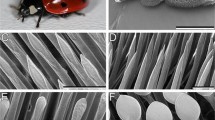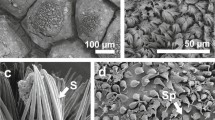Abstract.
To enable strong attachment forces between pad and substrata, a high proximity between contacting surfaces is required. One of the mechanisms, which can provide an intimate contact of solids, is a high flexibility of both materials. It has been previously presumed that setae of hairy attachment pads of insects are composed of flexible cuticle, and are able to replicate the surface profile. The aim of this work was to visualise the contact behaviour of the setae by freezing-substitution technique to understand setal mechanics while adhering to a smooth surface. This approach revealed considerable differences in the area of the setal tips between contacting and non-contacting pulvilli. Based on the assumption that setae behave like a spring pushed by the tip, a spring constant of 1.31 N m–1 was calculated from direct measurements of single setae by atomic force microscopy. In order to explain the relationship between the behaviour of the attachment setae at a microscale and leg movements, high-speed video recordings were made of walking flies. This data show that some proximal movement of the leg is present during contact formation with the substrate.
Similar content being viewed by others
Author information
Authors and Affiliations
Additional information
Electronic Publication
Rights and permissions
About this article
Cite this article
Niederegger, S., Gorb, S. & Jiao, Y. Contact behaviour of tenent setae in attachment pads of the blowfly Calliphora vicina (Diptera, Calliphoridae). J Comp Physiol A 187, 961–970 (2002). https://doi.org/10.1007/s00359-001-0265-7
Accepted:
Issue Date:
DOI: https://doi.org/10.1007/s00359-001-0265-7




